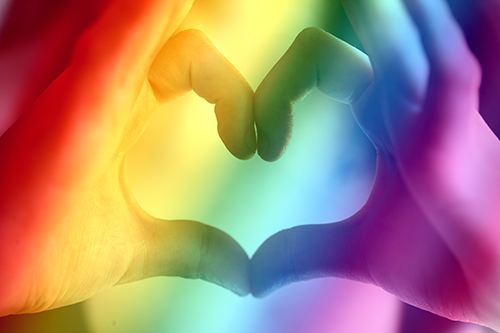Domestic and Sexual Violence 24-Hour Hotline 703-360-7273; TTY 711
 SAFETY ALERT – If you are in danger, call or text 911.
SAFETY ALERT – If you are in danger, call or text 911.
 For National Coming Out Day (October 11), Domestic and Sexual Violence Services is sharing this LGBTQIA+ language guidance* related to sexual orientation, gender identity, and expression. It should be used as a resource to better understand the most recent language used in LGBTQIA+ communities, but it is not exhaustive. Since people use language in different ways, the best practice is always to honor language an individual uses to identify themselves.
For National Coming Out Day (October 11), Domestic and Sexual Violence Services is sharing this LGBTQIA+ language guidance* related to sexual orientation, gender identity, and expression. It should be used as a resource to better understand the most recent language used in LGBTQIA+ communities, but it is not exhaustive. Since people use language in different ways, the best practice is always to honor language an individual uses to identify themselves.
| Updated Language | Outdated Language | Why It Matters |
|---|---|---|
| Another gender, another sex | Opposite sex, opposite gender | "Opposite" implies there are only two genders or two sexes. It does not acknowledge the existence of nonbinary or intersex individuals. |
| Bisexual defined as attraction to more than one gender | Bisexual defined as an attraction to both men and women | The outdated language incorrectly assumes there are only two genders when there are multiple genders. Best practice acknowledges a bi+ person may be attracted to more than one gender at a time, though not necessarily at the same time or in the same way. |
| Gender affirming surgery | Sex change, sex reassignment surgery, gender reassignment surgery | In this instance, "sex" is a stand-in for "gender," but gender doesn't change when someone undergoes an operation. They already identify as said gender; these surgeries instead affirm their gender. |
| Identifies as transgender, man, woman, or nonbinary | Used to be a man or woman; was born a boy or girl | Never say someone "used to be" another gender or "was born" another gender. A person's gender identity is valid from the moment they disclose it, regardless of whether you previously knew them by a different name or pronouns. |
| Lesbian, gay, bisexual, pansexual, queer, straight, etc. | Heterosexual or homosexual | The term homosexual has a history of medicalization and has often been used as a derogatory term. |
| Pronouns, correct pronouns, proper pronouns, name, correct name | Preferred pronouns, preferred name | A person's name and pronouns are their name and pronouns, not simply a preference. Using someone's correct name and pronouns is a way to show respect. Unsure of someone's pronouns? Use gender-neutral pronouns, i.e., they, them, theirs. |
| Rejecting or affirming behaviors | Rejecting or affirming families | Outdated language stigmatizes families by characterizing them as wholly accepting or wholly rejecting. Many families move across a spectrum of showing accepting and rejecting behaviors. Additionally, families may be struggling to learn what is supporting to their LGBTQIA+ family member. Language should focus on changing behaviors, not the family. |
| Sexual orientation or gender identity | Lifestyle, choice, or preference | When referring to pronouns or identity, "lifestyle," "choice," or "preference" is dismissive to the lived experience of those who identify as LGBTQIA+. |
| Using transgender as an adjective | Using transgender as a verb or noun | Transgender is an adjective and should be used as such: transgender person, transgender community, transgender pride flag. |
| They/them/theirs | Gendered language in printed materials (e.g., brochures, policies) which have references to he or she, she/he, or (s)he | Using he or she or another variation implies these are the only two pronouns people use and does not acknowledge the existence of people who use any other pronouns. Instead of "the client is best suited to tell you about his or her needs," use "the client is best suited to tell you their needs." |
| Transgender | Transsexual | Transsexual is an older term. It is still used by some who have changed or seek to change their bodies through medical interventions. Many transgender people do not identify as transsexual and use transgender or trans. Best practice: Ask how someone identifies and use the term they request. |
| Transgender man or trans man, transgender woman or trans woman, transgender boy or trans boy, transgender girl or trans girl | Transgender male or transgender female | When asking questions about gender, use "man" or "boy" and "woman" or "girl" instead of "male" or "female" because male and females are typically used to describe sex assigned at birth. |
| Two-spirit | Indigenous communities use the term Two-Spirit. | Most indigenous communities had or have their own dialects with unique words to describe all of their recognized sexual orientations and gender identities. Some native languages were exterminated through colonization and Two-Spirit became a new word that some communities adopted to describe people who exist out of expected gender and sexuality norms. It is not accepted by all indigenous communities. |
*Adapted from the Center of Excellence on LGBTQ+ Behavioral Health Equity

